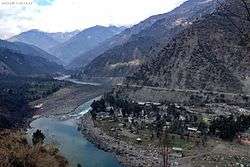Chenab Valley
Chenab Valley, also known as the Chenab Region, is the river valley of the Chenab River flowing through the Kishtwar, Doda, and Ramban districts of Jammu Division in Jammu and Kashmir, India.[1][2]
Chenab Valley | |
|---|---|
Region | |
 Chenab River at Ramban | |
| Country | |
| Union Territory | Jammu and Kashmir |
| Districts |
|
Location
Erstwhile Doda lies between the middle and outer Himalayan range in the Jammu region of Jammu and Kashmir, India. It is divided into three districts: Doda, Ramban, and Kishtwar and 1 sub-division of Reasi are also believed to be a part of this sub-region. The valley touches the Anantnag district of J&K to the north, the Chamba district of Himachal Pradesh, and Kathua district to the South, the Udhampur district to the southwest, and Salal Reasi Subdivision to the West, with Doda in its middle.
Geography
Chenab Valley has mostly hilly terrain. The Chenab River flows through all the districts of Chenab Valley including Doda district, Kishtwar District, Ramban District & Reasi district. The area is an active seismic zone.[3]
History
The demography of Chenab valley which is referred to erstwhile Doda district is complex as compared to its neighbouring districts primarily because of the wide diversity in its population. In the past, Doda was largely inhabited by Sarazi population before people started settling here from Kashmir and other adjoining areas.[4][5] The reasons for kashmiri population settling here in the past in 17th and 18th century is matter of ambiguity between historians.[6] However Sumantra Bose says it was repression by feudal class that drew people to the district of Doda, Ramban and Kishtwar.[7][8]
The Chenab valley consists of areas drawn from the ancient principalities of Kishtwar and Bhadarwah, both of which became part of a district by the name of Udhampur in the princely state of Jammu and Kashmir.
People
Kashmiris form majority in Chenab Valley but Gujjars, Paharis & Bhaderwahis have also significant population. Chenab Valley is rich in cultural heritage and ethical values, but also has age-old traditions of secularism and tolerance.[7] Though this place has also faced rising insurgency. During the rise of insurgency in Kashmir in early 1990's, this place was second most affected place in the state of Jammu and Kashmir. The main occupations of the people of the valley are farming and cattle rearing.
Languages
Chenab Valley is home to a variety of ethnic groups. Among the languages spoken in Chenab Valley are the following:[9] Kashmiri & it's dialects Kishtwari, Rambani & Pogali is the most widely spoken language in the region. Other languages include Gojri, Pahari language, Bhaderwahi, Dogri & Ladakhi.
Tourist destinations
- Bhaderwah Valley, located in Doda district is a famous tourist destination of Chenab Valley.
- Jai Valley, located in Bhaderwah, Jammu and Kashmir.
- Chinta Valley, also located in Bhaderwah, Jammu and Kashmir.
- Jantroon Dhar, are the large meadows, located in Thathri subdivision of Doda district.
- Padri Top, is the group of meadows, located in Bhaderwah.
- Bimal Nag, is a meadow located in Drabshalla tehsil (subdistrict) of Kishtwar district.
- Mughal Maidan, a tourist destination in Kishtwar district.
- Chatroo, famous for it small lake, is a tourist destination in Kishtwar district.
- Sinthan Pass, located in the higher reaches of Kishtwar district on Kishtwar-Anantnag road.
- Bhal Padri, a beautiful meadow located in Gandoh (Bhalessa).
- Lal Draman, a scenic tourist destination in Doda district.
- Dessa Valley, located in Doda district.
Natural disasters
- A 5.8 earthquake hit the Erstwhile Doda on May 1, 2013, killing two and injuring 69.[10] Seismic activity continued in the valley throughout 2013, prompting teams of seismologists to study the area. A local belief states that the earthquakes were being caused by hydroelectric construction projects in the area.[11]
- Flash floods wreaked havoc in Thathri town of Doda district of J&K, inundating vast areas along the Batote- Kishtwar National Highway and washing away half a dozen houses. Six persons were killed in the flash floods[12]
References
- "Geelani vows to resist settlement of retired soldiers in Kashmir".
- "THROUGH THE PIR PANJAL".
- "Chenab valley quakes not due to hydro projects: Scientists"
- "Sarazi: Endangered Language of the Chenab Valley". Retrieved 16 July 2020.
- "Story of Doda misunderstood by Kashmir". Greater Kashmir. 13 March 2015. Retrieved 16 July 2020.
- "Mini Kashmir". Kashmir Life. 11 January 2011. Retrieved 16 July 2020.
- Snedden, Christopher (2015), Understanding Kashmir and Kashmiris, Oxford University Press, p. xxi, 23, ISBN 978-1-84904-342-7
- "Sarazi: Endangered Language of the Chenab Valley". Sahapedia. Retrieved 16 July 2020.
- N. Koul, Omkar. "Spoken Kashmiri - A language course". Retrieved 16 July 2020.
- "IIT scientists, NDMA assess damages in quake-hit Erstwhile Doda"
- "Erstwhile doda quakes not due to hydro projects: Scientists"
- "Chenab Valley: 6 Killed in Thathri Floods"